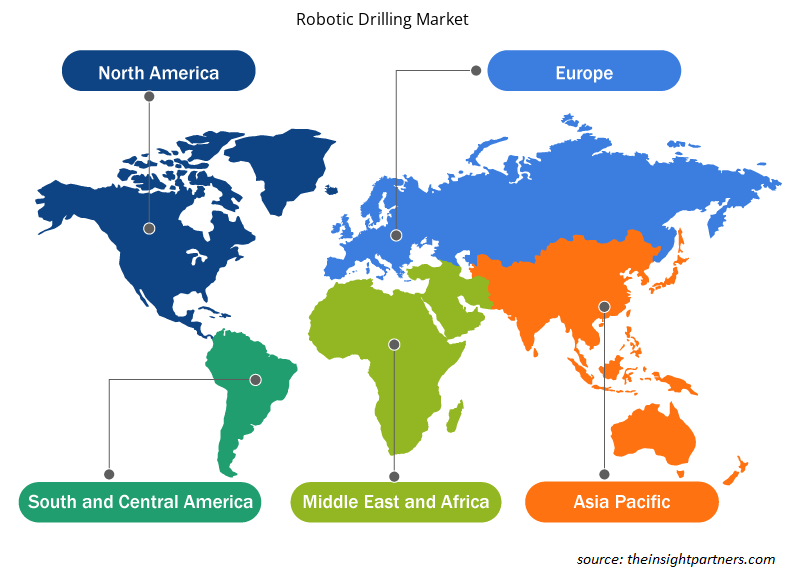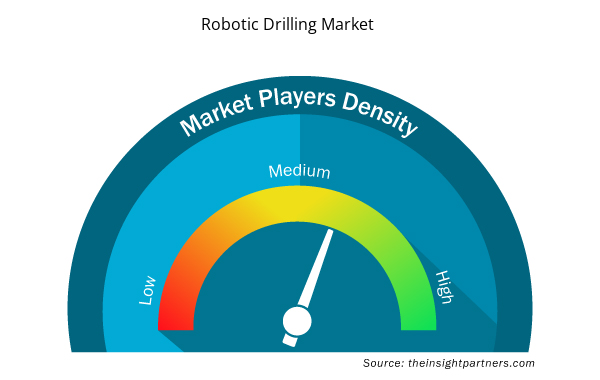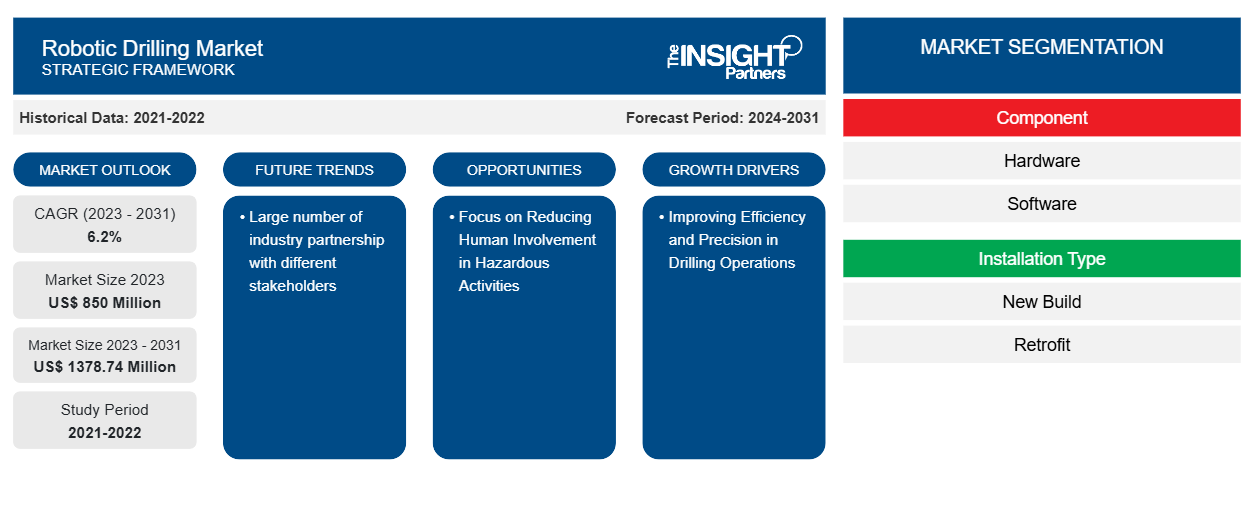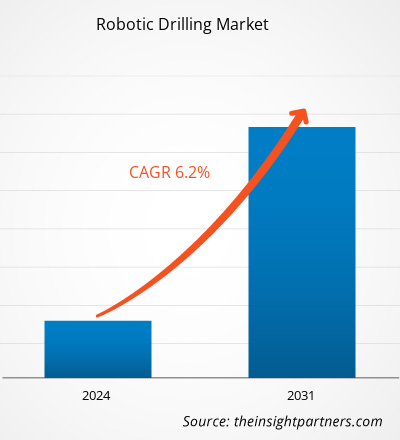Der Markt für robotergestütztes Bohren soll von 850 Millionen US-Dollar im Jahr 2023 auf 1.378,74 Millionen US-Dollar im Jahr 2031 anwachsen. Der Markt soll in den Jahren 2023–2031 eine durchschnittliche jährliche Wachstumsrate (CAGR) von 6,2 % verzeichnen. Die zunehmende Bohraktivität treibt das Marktwachstum vor allem aufgrund der Erschließung außergewöhnlicher Kohlenwasserstoffvorkommen und der Einführung von Automatisierung und Robotern bei der Öl- und Gasförderung voran. Dies führt zu höherer Effizienz und verbesserter Bohranlagensicherheit.
Roboterbohren Marktanalyse
Verstärkte Explorationsaktivitäten sowie der Fokus auf die risikofreie, kostengünstige und zeitsparende Erschließung neuer Öl- und Gasfelder werden den Markt für Roboterbohrsysteme voraussichtlich ankurbeln. Die Volatilität der Ölpreise in den letzten Jahren, Bedenken hinsichtlich der Cybersicherheit und hohe Anfangskosten haben das Wachstum der Roboterbohrindustrie jedoch gebremst.
Marktübersicht für robotergestütztes Bohren
Roboterbohren ist eine führende Technologie für autonome Bohrvorgänge. Bohrrobotersteuerungen gewährleisten einen sicheren und effizienten Betrieb und reduzieren gleichzeitig menschliche Fehler. Mit dem Wachstum von Bevölkerung und Städten hat die weltweite Abhängigkeit von fossilen Brennstoffen zu einem rasanten Anstieg der Nachfrage nach Öl und Gas geführt. Dies hat zu einem Anstieg der Bohraktivitäten geführt. Der Einsatz von Roboterbohren bei der Öl- und Gasexploration nimmt zu, wobei die Branche aufgrund der zunehmenden Industrialisierung und der Ausbeutung unkonventioneller Kohlenwasserstoffreserven wahrscheinlich expandieren wird. Der Ausbau der Stromerzeugung , insbesondere in Schwellenländern, dürfte das Marktwachstum ankurbeln. Darüber hinaus wirken Entwicklungen in der Robotertechnologie als indirekter Treiber und beschleunigen die Wachstumskurve des Marktes für Roboterbohren.
Passen Sie diesen Bericht Ihren Anforderungen an
Sie erhalten kostenlos individuelle Anpassungen an jedem Bericht, einschließlich Teilen dieses Berichts oder einer Analyse auf Länderebene, eines Excel-Datenpakets sowie tolle Angebote und Rabatte für Start-ups und Universitäten.
- Holen Sie sich die wichtigsten Markttrends aus diesem Bericht.Dieses KOSTENLOSE Beispiel umfasst eine Datenanalyse von Markttrends bis hin zu Schätzungen und Prognosen.
Treiber und Chancen auf dem Markt für robotergestütztes Bohren
Verbesserung der Effizienz und Präzision bei Bohrvorgängen zur Förderung des Marktes
Das ständige Streben nach betrieblicher Effizienz und Präzision bei Bohrvorgängen in einer Vielzahl von Branchen, darunter Öl und Gas, Bergbau und Produktion. Roboterbohrsysteme verbessern die Genauigkeit, reduzieren menschliche Fehler und erhöhen die Standardproduktivität. Der wichtigste Faktor bei Bohrvorgängen ist die Sicherheit, da Roboterstrukturen die Exposition des Menschen gegenüber gefährlichen Umgebungen, insbesondere auf hoher See und in schwierigem Gelände, verringern.
Fokus auf die Reduzierung der menschlichen Beteiligung an gefährlichen Aktivitäten
Um die Belastung des Menschen durch gefährliche Bohrszenarien zu begrenzen, legen Unternehmen im Bereich der robotergestützten Bohrungen Wert auf Sicherheit und Risikominimierung. Bei herkömmlichen Bohrvorgängen, typischerweise in Branchen wie der Öl- und Gasförderung, dem Bergbau und dem Bauwesen, sind menschliche Arbeitskräfte für körperlich anstrengende und riskante Aufgaben erforderlich. Die robotergestützte Bohrtechnologie hat Bohrvorgänge sicherer gemacht und die Geschäftslandschaft verändert. Robotergestütztes Bohren verringert die Notwendigkeit menschlicher Beteiligung an gefährlichen Bohraktivitäten. Diese Vorgänge werden oft an anspruchsvollen oder abgelegenen Orten durchgeführt, beispielsweise in gefährlichen Minen, auf Offshore-Ölplattformen oder Tiefseeplattformen.
Mitarbeiter in diesen Situationen sind verschiedenen Risiken ausgesetzt, darunter Unfällen, dem Kontakt mit giftigen Produkten und extremen Wetterbedingungen. Unternehmen können Roboterbohrgeräte einsetzen, um Risiken zu verringern und die Sicherheit der Mitarbeiter zu verbessern.
Segmentierungsanalyse des Marktberichts zum Roboterbohren
Wichtige Segmente, die zur Ableitung der Marktanalyse für robotergestütztes Bohren beigetragen haben, sind Komponente, Installationstyp und Anwendung.
- Basierend auf den Komponenten ist der Markt für robotergestütztes Bohren in Hardware und Software unterteilt.
- Nach Installationstyp ist der Markt in Neubau und Nachrüstung segmentiert
- BezüglichAnwendung ist der Markt in Onshore und Offshore segmentiert.
Roboterbohren Marktanteilsanalyse nach Geografie
Der geografische Umfang des Marktberichts für Roboterbohren ist hauptsächlich in fünf Regionen unterteilt: Nordamerika, Asien-Pazifik, Europa, Naher Osten und Afrika sowie Südamerika/Süd- und Mittelamerika. Aufgrund der jüngsten Schiefergasentwicklung in Nordamerika ist der Markt für Roboterbohrgeräte dramatisch gewachsen. Auch die Exploration im Golf von Mexiko nimmt zu, was den regionalen Markt für Roboterbohrsysteme antreibt. Höhere, niedrigere Bohrkosten und Ölpreise haben zu einem starken Anstieg der Offshore-Bohranlagen und der Ölproduktion in den USA geführt, was auf eine Ausweitung der Offshore-Bohrungen hindeutet, die voraussichtlich ein wichtiger Treiber für den Roboterbohrmarkt des Landes sein wird.
Regionale Einblicke in den Markt für robotergestütztes Bohren
Die regionalen Trends und Faktoren, die den Markt für Roboterbohren im gesamten Prognosezeitraum beeinflussen, wurden von den Analysten von Insight Partners ausführlich erläutert. In diesem Abschnitt werden auch die Marktsegmente und die Geografie des Roboterbohrens in Nordamerika, Europa, im asiatisch-pazifischen Raum, im Nahen Osten und Afrika sowie in Süd- und Mittelamerika erörtert.

- Erhalten Sie regionalspezifische Daten zum Markt für Roboterbohren
Umfang des Marktberichts zum robotergestützten Bohren
| Berichtsattribut | Details |
|---|---|
| Marktgröße im Jahr 2023 | 850 Millionen US-Dollar |
| Marktgröße bis 2031 | 1378,74 Millionen US-Dollar |
| Globale CAGR (2023 - 2031) | 6,2 % |
| Historische Daten | 2021-2022 |
| Prognosezeitraum | 2024–2031 |
| Abgedeckte Segmente | Nach Komponente
|
| Abgedeckte Regionen und Länder | Nordamerika
|
| Marktführer und wichtige Unternehmensprofile |
|
Dichte der Marktteilnehmer für robotergestütztes Bohren: Auswirkungen auf die Geschäftsdynamik verstehen
Der Markt für Roboterbohrtechnik wächst rasant, angetrieben durch die steigende Nachfrage der Endnutzer aufgrund von Faktoren wie sich entwickelnden Verbraucherpräferenzen, technologischen Fortschritten und einem größeren Bewusstsein für die Vorteile des Produkts. Mit steigender Nachfrage erweitern Unternehmen ihr Angebot, entwickeln Innovationen, um die Bedürfnisse der Verbraucher zu erfüllen, und nutzen neue Trends, was das Marktwachstum weiter ankurbelt.
Die Marktteilnehmerdichte bezieht sich auf die Verteilung von Firmen oder Unternehmen, die in einem bestimmten Markt oder einer bestimmten Branche tätig sind. Sie gibt an, wie viele Wettbewerber (Marktteilnehmer) in einem bestimmten Marktraum im Verhältnis zu seiner Größe oder seinem gesamten Marktwert präsent sind.
Die wichtigsten auf dem Markt für Roboterbohren tätigen Unternehmen sind:
- Bäcker Hughes
- Schlumberger
- Halliburton
- Raupe
- Nationale Ölquelle Varco
- Atlas Copco
Haftungsausschluss : Die oben aufgeführten Unternehmen sind nicht in einer bestimmten Reihenfolge aufgeführt.

- Überblick über die wichtigsten Akteure auf dem Markt für robotergestütztes Bohren
Nachrichten und aktuelle Entwicklungen zum Markt für robotergestütztes Bohren
Der Markt für Roboterbohren wird durch die Erfassung qualitativer und quantitativer Daten nach Primär- und Sekundärforschung bewertet, die wichtige Unternehmensveröffentlichungen, Verbandsdaten und Datenbanken umfasst. Im Folgenden finden Sie eine Liste der Entwicklungen auf dem Markt:
- Im März 2021 erhielt Schlumberger einen 480-Millionen-USD-Auftrag zur Bohrung von 96 Ölquellen im Südirak für die Basra Oil Company und ExxonMobil, die das riesige Feld West Qurna-1 mit Partnern aus dem Irak, Japan, Indonesien und China betreiben.
(Quelle: Schlumberger, Unternehmenswebsite, 2021)
- Im Oktober 2021 stellte Nabors Industries Ltd die vollautomatische Landbohranlage PACE-R801 vor, die mit Canrig-Robotik ausgestattet ist. Mit ihrer ersten Bohrung im Permian Basin erreichte sie die volle Tiefe. Das Unternehmen entwickelte einen autonomen Bohranlagenboden, um Besatzungen aus den roten Zonen zu eliminieren und eine konstante Bohrleistung zu gewährleisten.
(Quelle: Nabors Industries Ltd, Unternehmenswebsite, 2021)
Marktbericht zum robotergestützten Bohren – Abdeckung und Ergebnisse
Der Bericht „Marktgröße und Prognose für robotergestütztes Bohren (2021–2031)“ bietet eine detaillierte Analyse des Marktes, die die folgenden Bereiche abdeckt:
- Marktgröße und Prognose auf globaler, regionaler und Länderebene für alle wichtigen Marktsegmente, die im Rahmen des Projekts abgedeckt sind
- Marktdynamik wie Treiber, Beschränkungen und wichtige Chancen
- Wichtige Zukunftstrends
- Detaillierte PEST/Porters Five Forces- und SWOT-Analyse
- Globale und regionale Marktanalyse mit wichtigen Markttrends, wichtigen Akteuren, Vorschriften und aktuellen Marktentwicklungen
- Branchenlandschaft und Wettbewerbsanalyse, einschließlich Marktkonzentration, Heatmap-Analyse, prominenten Akteuren und aktuellen Entwicklungen
- Detaillierte Firmenprofile
- Historische Analyse (2 Jahre), Basisjahr, Prognose (7 Jahre) mit CAGR
- PEST- und SWOT-Analyse
- Marktgröße Wert/Volumen – Global, Regional, Land
- Branche und Wettbewerbsumfeld
- Excel-Datensatz


- Employment Screening Services Market
- Industrial Inkjet Printers Market
- Trade Promotion Management Software Market
- Blood Collection Devices Market
- Medical Second Opinion Market
- HVAC Sensors Market
- Influenza Vaccines Market
- Extracellular Matrix Market
- Latent TB Detection Market
- Grant Management Software Market

Report Coverage
Revenue forecast, Company Analysis, Industry landscape, Growth factors, and Trends

Segment Covered
This text is related
to segments covered.

Regional Scope
North America, Europe, Asia Pacific, Middle East & Africa, South & Central America

Country Scope
This text is related
to country scope.
Häufig gestellte Fragen
The global robotic drilling market is expected to reach US$ 1378.74 million by 2031.
The key players holding the majority of shares in the global robotic drilling market are Baker Hughes, Schlumberger, Halliburton, Caterpillar, and National Oilwell Varco.
A large number of industry partnerships with different stakeholders to play a significant role in the global robotic drilling market in the coming years.
Improving efficiency and precision in drilling operations are the major factors that propel the global robotic drilling market.
The global robotic drilling market was estimated to be US$ 850 million in 2023 and is expected to grow at a CAGR of 6.2% during the forecast period 2023 - 2031.
Trends and growth analysis reports related to Electronics and Semiconductor : READ MORE..
The Insight Partners performs research in 4 major stages: Data Collection & Secondary Research, Primary Research, Data Analysis and Data Triangulation & Final Review.
- Data Collection and Secondary Research:
As a market research and consulting firm operating from a decade, we have published and advised several client across the globe. First step for any study will start with an assessment of currently available data and insights from existing reports. Further, historical and current market information is collected from Investor Presentations, Annual Reports, SEC Filings, etc., and other information related to company’s performance and market positioning are gathered from Paid Databases (Factiva, Hoovers, and Reuters) and various other publications available in public domain.
Several associations trade associates, technical forums, institutes, societies and organization are accessed to gain technical as well as market related insights through their publications such as research papers, blogs and press releases related to the studies are referred to get cues about the market. Further, white papers, journals, magazines, and other news articles published in last 3 years are scrutinized and analyzed to understand the current market trends.
- Primary Research:
The primarily interview analysis comprise of data obtained from industry participants interview and answers to survey questions gathered by in-house primary team.
For primary research, interviews are conducted with industry experts/CEOs/Marketing Managers/VPs/Subject Matter Experts from both demand and supply side to get a 360-degree view of the market. The primary team conducts several interviews based on the complexity of the markets to understand the various market trends and dynamics which makes research more credible and precise.
A typical research interview fulfils the following functions:
- Provides first-hand information on the market size, market trends, growth trends, competitive landscape, and outlook
- Validates and strengthens in-house secondary research findings
- Develops the analysis team’s expertise and market understanding
Primary research involves email interactions and telephone interviews for each market, category, segment, and sub-segment across geographies. The participants who typically take part in such a process include, but are not limited to:
- Industry participants: VPs, business development managers, market intelligence managers and national sales managers
- Outside experts: Valuation experts, research analysts and key opinion leaders specializing in the electronics and semiconductor industry.
Below is the breakup of our primary respondents by company, designation, and region:

Once we receive the confirmation from primary research sources or primary respondents, we finalize the base year market estimation and forecast the data as per the macroeconomic and microeconomic factors assessed during data collection.
- Data Analysis:
Once data is validated through both secondary as well as primary respondents, we finalize the market estimations by hypothesis formulation and factor analysis at regional and country level.
- Macro-Economic Factor Analysis:
We analyse macroeconomic indicators such the gross domestic product (GDP), increase in the demand for goods and services across industries, technological advancement, regional economic growth, governmental policies, the influence of COVID-19, PEST analysis, and other aspects. This analysis aids in setting benchmarks for various nations/regions and approximating market splits. Additionally, the general trend of the aforementioned components aid in determining the market's development possibilities.
- Country Level Data:
Various factors that are especially aligned to the country are taken into account to determine the market size for a certain area and country, including the presence of vendors, such as headquarters and offices, the country's GDP, demand patterns, and industry growth. To comprehend the market dynamics for the nation, a number of growth variables, inhibitors, application areas, and current market trends are researched. The aforementioned elements aid in determining the country's overall market's growth potential.
- Company Profile:
The “Table of Contents” is formulated by listing and analyzing more than 25 - 30 companies operating in the market ecosystem across geographies. However, we profile only 10 companies as a standard practice in our syndicate reports. These 10 companies comprise leading, emerging, and regional players. Nonetheless, our analysis is not restricted to the 10 listed companies, we also analyze other companies present in the market to develop a holistic view and understand the prevailing trends. The “Company Profiles” section in the report covers key facts, business description, products & services, financial information, SWOT analysis, and key developments. The financial information presented is extracted from the annual reports and official documents of the publicly listed companies. Upon collecting the information for the sections of respective companies, we verify them via various primary sources and then compile the data in respective company profiles. The company level information helps us in deriving the base number as well as in forecasting the market size.
- Developing Base Number:
Aggregation of sales statistics (2020-2022) and macro-economic factor, and other secondary and primary research insights are utilized to arrive at base number and related market shares for 2022. The data gaps are identified in this step and relevant market data is analyzed, collected from paid primary interviews or databases. On finalizing the base year market size, forecasts are developed on the basis of macro-economic, industry and market growth factors and company level analysis.
- Data Triangulation and Final Review:
The market findings and base year market size calculations are validated from supply as well as demand side. Demand side validations are based on macro-economic factor analysis and benchmarks for respective regions and countries. In case of supply side validations, revenues of major companies are estimated (in case not available) based on industry benchmark, approximate number of employees, product portfolio, and primary interviews revenues are gathered. Further revenue from target product/service segment is assessed to avoid overshooting of market statistics. In case of heavy deviations between supply and demand side values, all thes steps are repeated to achieve synchronization.
We follow an iterative model, wherein we share our research findings with Subject Matter Experts (SME’s) and Key Opinion Leaders (KOLs) until consensus view of the market is not formulated – this model negates any drastic deviation in the opinions of experts. Only validated and universally acceptable research findings are quoted in our reports.
We have important check points that we use to validate our research findings – which we call – data triangulation, where we validate the information, we generate from secondary sources with primary interviews and then we re-validate with our internal data bases and Subject matter experts. This comprehensive model enables us to deliver high quality, reliable data in shortest possible time.


 Holen Sie sich ein kostenloses Muster für diesen Bericht
Holen Sie sich ein kostenloses Muster für diesen Bericht